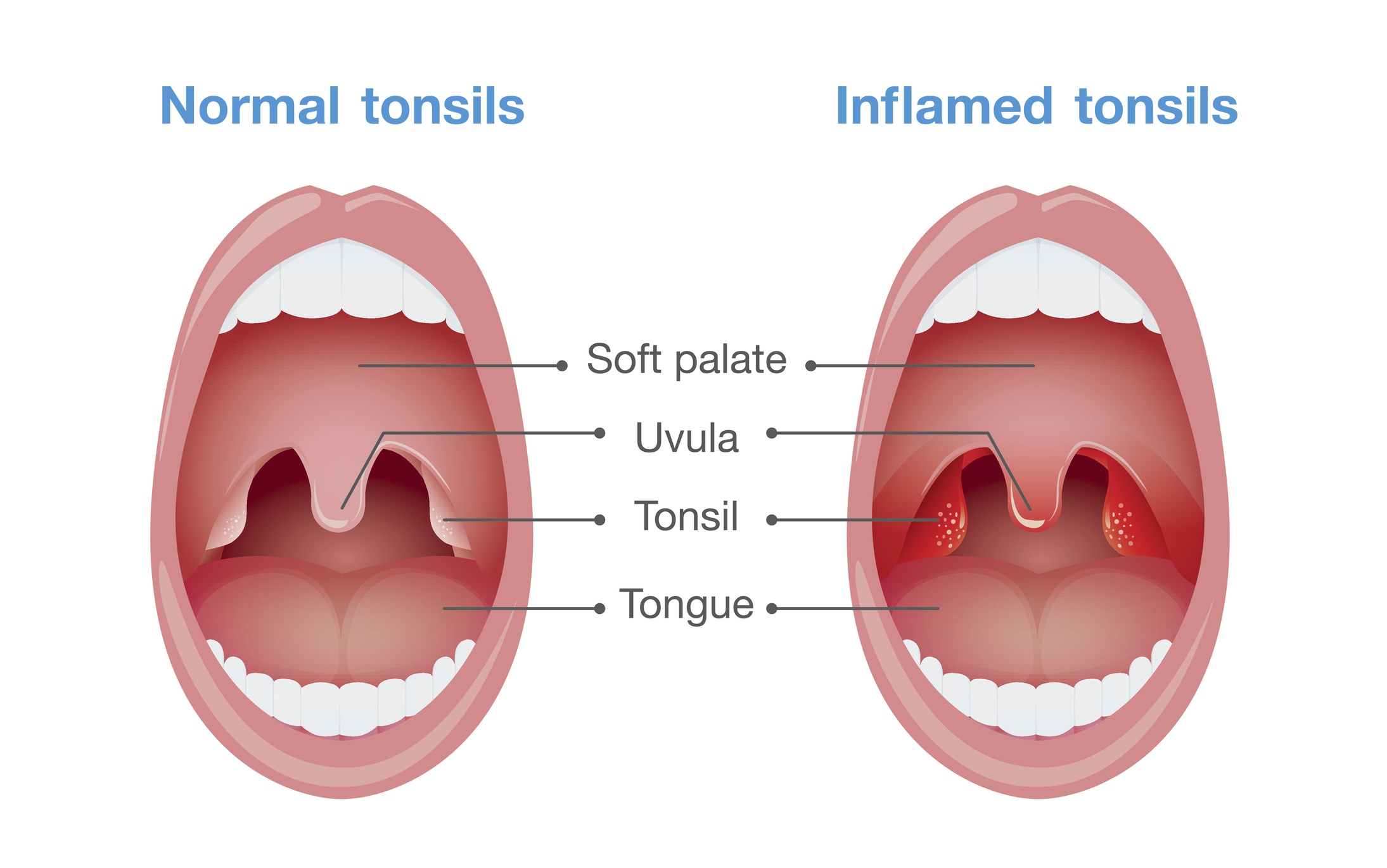- Home
- Mind & body
- Swollen tonsils: is it tonsillitis?
At CBHS we help you manage your health challenges. We believe in offering you the services, support and tools you need to live your best life.
Health and Wellness Programs are available to support eligible members towards a healthier lifestyle. Each Health and Wellness Program is subject to its own eligibility criteria.
Contact us for more information and to confirm your eligibility for a program.
Swollen tonsils: is it tonsillitis?

Tonsilitis is an infection that causes a sore throat, and sometimes fever. Treatment can vary depending on how severe the infection is, if bacteria or virus are responsible, and how often infections occur.
Why do we need tonsils?
Given how often tonsils get infected - especially in children and young people - you might wonder why we need them.
“The bacteria and germs that tonsils fight can sometimes infect the tonsils themselves.”
Tonsils are part of your immune system. They form a protective ring around the opening to your throat to help prevent germs (bacteria and viruses) entering your body through your mouth or nose. Tonsils make white blood cells and antibodies, which are responsible for killing germs. The immune system function of tonsils is more active before puberty, which could explain why tonsillitis is more common in children.
The soft pads at the back of your mouth, on either side of your throat, are the only set of tonsils you can see, although we have more than one set. The adenoids behind the nose are considered tonsils, and so is the lingual tonsil at the back of the tongue.
What is tonsillitis?
The bacteria and germs that tonsils fight can sometimes infect the tonsils themselves. When that happens, the tonsils swell up and become red and inflamed, sometimes with white or yellowish spots. This is called tonsillitis.
Although tonsillitis is common in children, teenagers and adults can get it too.
Tonsillitis causes
The most common cause of tonsillitis is a viral infection. Bacterial infections are far less common and only account for around 15% of cases.
Tonsillitis symptoms
As well as the symptoms listed below, tonsillitis can feel like having a cold or flu. The symptoms of tonsillitis can include:
- red, swollen, or irritated tonsils
- sore throat
- pain when swallowing
- yellow or white pus spots on the tonsils
- feeling tired
- swollen glands in the jaw
- bad breath
- headache
- fever
- earache
- loss of appetite.

Is tonsillitis contagious?
Tonsillitis itself isn’t contagious, but most of the viral infections that cause tonsillitis are colds and flu. If you contract tonsillitis, or if you are caring for someone with tonsillitis, sneeze into disposable tissues before throwing them away, wash your hands frequently and don’t share drinking vessels.
How do you treat tonsillitis?
In most cases, symptoms of tonsillitis usually go away within three to four days.
Viral infections cause most cases of tonsillitis (around 85%). Antibiotics won’t work on viral infections, which is why treatment in most cases of tonsillitis concentrates on relieving the symptoms:
- Get plenty of rest
- Drink lots of cool fluids to soothe the throat
- Icy poles and ice-cream can be helpful for children
- Eat softer food that won’t irritate the throat
- Pain relief such as paracetamol or ibuprofen might be appropriate.
In the remaining 15% of cases, if a bacterial infection is present, antibiotics might be useful. The only way to confirm the type of infection is through a throat swab, which your GP can then send away for testing.
If your doctor recommends antibiotics to you or your child, be sure to complete the full course.
Tonsillitis complications
- Secondary infections can spread to the nose, sinus, and ears
- Chronic infections which don’t clear up can leave you feeling tired and unwell
- If the adenoids also swell up, this can lead to glue ear
- If infection spreads beyond the tonsils, an abscess can form ( quinsy) which can cause severe pain and restrict breathing and swallowing. Antibiotics may help, and an operation may be required.
If the symptoms of tonsillitis persist or become severe, or if you or your child experience any complications, seek medical help. See your GP immediately or call triple zero (000) or visit the emergency department of your local hospital if you suspect quinsy.
What else can cause swollen tonsils?
Swollen tonsils may have other causes apart from tonsillitis, such as:
- tonsil stones that form at the back of your throat
- lesions on your vocal cords
- tonsil cancer, especially if the swelling is one-sided
- herpes simplex type 1 (HSV-1)
- measles.
However, if you look in your child’s throat, and their tonsils are red and swollen, the most likely cause is tonsillitis.
Should you have your tonsils removed?
Your specialist may recommend surgery if you or your child experience frequent, chronic, or severe bacterial infections that don’t respond to treatment, or if enlarged tonsils make it harder to breathe. As a guide, ‘frequent’ is at least seven infections in the past year, at least five a year for two years, or at least three a year over a period of three years. Talk to your doctor about the benefits and risks of surgery before you decide if a tonsillectomy is right for you or your child.
A 2018 study found a significant increase in the risk of later respiratory, allergic, and infectious diseases in children who had had their tonsils or adenoids removed.
Tonsillectomy surgery is performed under general anaesthetic. The operation takes around 20-30 minutes, and most people can go home the same day. Recovery should take around two weeks. Rest, plenty of fluids and soft bland food are recommended. During the recovery period you may experience:
- sore throat
- bad breath
- ear pain
- vocal changes
- white patches on the tonsils.
After a tonsillectomy, you are likely to experience fewer sore throats if the previous cases of tonsillitis were caused by bacterial infections. The Royal Children’s Hospital in Melbourne has more information on how to care for a child following a tonsillectomy operation.
Can you claim on health insurance for a tonsillectomy?
Tonsillectomy is included on all CBHS Hospital and packaged covers as a private patient in a private hospital (except on Basic Plus Hospital which has restricted benefits). Like any other treatment, there may be out-of-pocket expenses for the doctors’ fees, depending on the specialist you choose.
You can check what’s included on your policy in the Member Centre, email help@cbhs.com.au or call our Member Care team on 1300 654 123, Monday to Friday, 8am-7pm AEST.
All information contained in this article is intended for general information purposes only. The information provided should not be relied upon as medical advice and does not supersede or replace a consultation with a suitably qualified healthcare professional.
Sources:
https://www.ncbi.nlm.nih.gov/books/NBK279406/
https://www.rch.org.au/kidsinfo/fact_sheets/Tonsillectomy_and_adenoidectomy_discharge_care/
Tonsillitis - Better Health Channel
Tonsil Stones (Tonsilloliths) | Causes, Symptoms & Treatment | Patient
Swollen Tonsils: Causes, Treatments, and More (healthline.com)
Health and wellbeing
programs & support
You Belong to More with CBHS Hospital cover:
- Greater choice over your health options including who treats you
- Get care at home with Hospital Substitute Treatment program
- Free health and wellbeing programs to support your health challenges
Live your healthiest, happiest life with CBHS Extras cover:
- Benefits for proactive health checks e.g. bone density tests, eye screenings
- Keep up your care with telehealth and digital options
- Save on dental and optical with CBHS Choice Network providers
